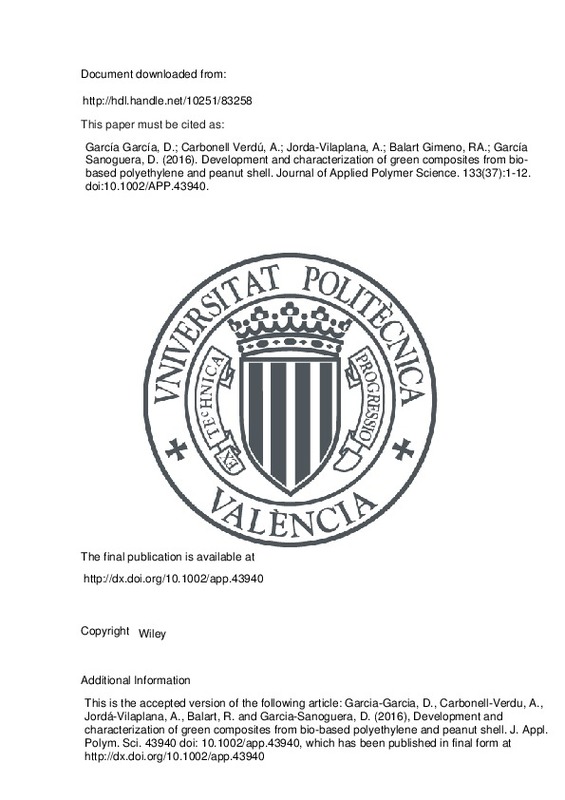JavaScript is disabled for your browser. Some features of this site may not work without it.
Buscar en RiuNet
Listar
Mi cuenta
Estadísticas
Ayuda RiuNet
Admin. UPV
Development and characterization of green composites from bio-based polyethylene and peanut shell
Mostrar el registro sencillo del ítem
Ficheros en el ítem
| dc.contributor.author | García García, Daniel
|
es_ES |
| dc.contributor.author | Carbonell Verdú, Alfredo
|
es_ES |
| dc.contributor.author | Jorda-Vilaplana, Amparo
|
es_ES |
| dc.contributor.author | Balart Gimeno, Rafael Antonio
|
es_ES |
| dc.contributor.author | García Sanoguera, David
|
es_ES |
| dc.date.accessioned | 2017-06-20T11:24:44Z | |
| dc.date.available | 2017-06-20T11:24:44Z | |
| dc.date.issued | 2016-10-05 | |
| dc.identifier.issn | 0021-8995 | |
| dc.identifier.uri | http://hdl.handle.net/10251/83258 | |
| dc.description | This is the accepted version of the following article: Garcia-Garcia, D., Carbonell-Verdu, A., Jordá-Vilaplana, A., Balart, R. and Garcia-Sanoguera, D. (2016), Development and characterization of green composites from bio-based polyethylene and peanut shell. J. Appl. Polym. Sci. 43940 doi: 10.1002/app.43940, which has been published in final form at http://dx.doi.org/10.1002/app.43940 | es_ES |
| dc.description.abstract | [EN] In the present work, different compatibilizers, namely polyethylene-graft-maleic anhydride (PE-g-MA), polypropylene-graftmaleic anhydride (PP-g-MA), and polystyrene-block-poly(ethylene-ran-butylene)-block-polystyrene-graft-maleic anhydride (SEBS-g-MA) were used on green composites derived from biobased polyethylene and peanut shell (PNS) flour to improve particle polymer interaction. Composites of high-density polyethylene/peanut shell powder (HDPE/PNS) with 10 wt % PNS flour were compatibilized with 3 wt % of the abovementioned compatibilizers. As per the results, PP-g-MA copolymer lead to best optimized properties as evidenced by mechanical characterization. In addition, best particle matrix interface interactions with PP-g-MA were observed by scanning electron microscopy (SEM). Subsequently HDPE/PNS composites with varying PNS flour content in the 5 30 wt % range with PP-g-MA compatibilizer were obtained by melt extrusion and compounding followed by injection molding and were characterized by mechanical, thermal, and morphological techniques. The results showed that PNS powder, leads to an increase in mechanical resistant properties (mainly, flexural modulus, and strength) while a decrease in mechanical ductile properties, that is, elongation at break and impact absorbed energy is observed with increasing PNS flour content. Furthermore, PNS flour provides an increase in thermal stability due to the natural antioxidant properties of PNS. In particular, composites containing 30 wt % PNS powder present a flexural strength 24% and a flexural modulus 72% higher than the unfilled polyethylene and the thermo-oxidative onset degradation temperature is increased from 232 8C up to 2548C thus indicating a marked thermal stabilization effect. Resultant composites can show a great deal of potential as base materials for wood plastic composites. | es_ES |
| dc.description.sponsorship | This research was supported by the Ministry of Economy and Competitiveness -MINECO, Ref: MAT2014-59242-C2-1-R. Authors also thank to "Conselleria d'Educacio, Cultura i Esport" - Generalitat Valenciana, Ref: GV/2014/008 for financial support. A. Carbonell-Verdu wants to thank Universitat Politecnica de Valencia for financial support through an FPI grant. D. Garcia-Garcia wants to thanks the Spanish Ministry of Education, Culture and Sports for the financial support through an FPU grant (FPU13/06011). | |
| dc.language | Inglés | es_ES |
| dc.publisher | Wiley | es_ES |
| dc.relation.ispartof | Journal of Applied Polymer Science | es_ES |
| dc.rights | Reserva de todos los derechos | es_ES |
| dc.subject | Biopolymers and renewable polymers | es_ES |
| dc.subject | Compatibilization | es_ES |
| dc.subject | Composites | es_ES |
| dc.subject | Mechanical properties | es_ES |
| dc.subject.classification | CIENCIA DE LOS MATERIALES E INGENIERIA METALURGICA | es_ES |
| dc.subject.classification | EXPRESION GRAFICA EN LA INGENIERIA | es_ES |
| dc.title | Development and characterization of green composites from bio-based polyethylene and peanut shell | es_ES |
| dc.type | Artículo | es_ES |
| dc.identifier.doi | 10.1002/APP.43940 | |
| dc.relation.projectID | info:eu-repo/grantAgreement/MINECO//MAT2014-59242-C2-1-R/ES/TECNICAS AVANZADAS DE PROCESADO PARA SISTEMAS ACTIVOS ENCAPSULADOS/ | es_ES |
| dc.relation.projectID | info:eu-repo/grantAgreement/GVA//GV%2F2014%2F008/ | es_ES |
| dc.relation.projectID | info:eu-repo/grantAgreement/MECD//FPU13%2F06011/ES/FPU13%2F06011/ | es_ES |
| dc.rights.accessRights | Abierto | es_ES |
| dc.contributor.affiliation | Universitat Politècnica de València. Instituto de Tecnología de Materiales - Institut de Tecnologia de Materials | es_ES |
| dc.contributor.affiliation | Universitat Politècnica de València. Escuela Politécnica Superior de Alcoy - Escola Politècnica Superior d'Alcoi | es_ES |
| dc.contributor.affiliation | Universitat Politècnica de València. Departamento de Ingeniería Gráfica - Departament d'Enginyeria Gràfica | es_ES |
| dc.description.bibliographicCitation | García García, D.; Carbonell Verdú, A.; Jorda-Vilaplana, A.; Balart Gimeno, RA.; García Sanoguera, D. (2016). Development and characterization of green composites from bio-based polyethylene and peanut shell. Journal of Applied Polymer Science. 133(37):1-12. https://doi.org/10.1002/APP.43940 | es_ES |
| dc.description.accrualMethod | S | es_ES |
| dc.relation.publisherversion | http://dx.doi.org/10.1002/app.43940 | es_ES |
| dc.description.upvformatpinicio | 1 | es_ES |
| dc.description.upvformatpfin | 12 | es_ES |
| dc.type.version | info:eu-repo/semantics/publishedVersion | es_ES |
| dc.description.volume | 133 | es_ES |
| dc.description.issue | 37 | es_ES |
| dc.relation.senia | 315122 | es_ES |
| dc.contributor.funder | Ministerio de Economía y Competitividad | |
| dc.contributor.funder | Generalitat Valenciana | |
| dc.contributor.funder | Ministerio de Educación, Cultura y Deporte |







![[Cerrado]](/themes/UPV/images/candado.png)

